Digital Poster
White Matter: Quantification
ISMRM & ISMRT Annual Meeting & Exhibition • 10-15 May 2025 • Honolulu, Hawai'i

 |
Computer Number: 65
1594. Periventricular
and Deep White Matter Hyperintensity Beyond a Threshold Impairs
Unique Cognitive Domains and Neuroanatomic Health
N. Gupta, V. Tiwari
Indian Institute of Science Education and Research (IISER) Berhampur, Berhampur, India
Impact: This study quantitatively establishes critical
volumetric thresholds of periventricular and deep white
matter hyperintensities, beyond which accelerated decline in
cognitive performance and neuroanatomic volume is observed.
This unique approach establishes clinical implications of
cerebral small vessel health and cognitive status.
|
|
 |
Computer Number: 66
1595. Optimization
of T1-w/T2-w ratio for myelin using different TE and exponents
S. Monachino, G. Drenthen, L. van den Boogaard, M. Breeuwer,
C. Fernandes, O. Gerlach, S. Zinger, J. Jansen
Eindhoven University of Technology, Eindhoven, Netherlands
Impact: The findings show potential for improving myelin
signal by using a generalized version of the T1-w/T2-w ratio
which can be easily computed from structural brain images.
Myelin integrity is a promising biomarker for the diagnosis
and monitoring of neurological disorders.
|
|
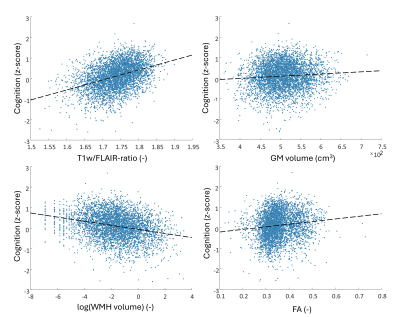 |
Computer Number: 67
1596. T1w/FLAIR-ratio
as a predictor for cognition in a large population cohort:
Findings from The Maastricht Study
G. Drenthen, W. Backes, S. Köhler, M. Schram, W. Jansen, J.
Jansen
Maastricht University Medical Center, Maastricht, Netherlands
Impact: The T1w/FLAIR-ratio can be used as a proxy for
the myelin content. Here, we showed in a large
population-based sample, that the T1w/FLAIR-ratio is a
better predictor for cognition compared to atrophy, white
matter lesion burden and microstructure.
|
|
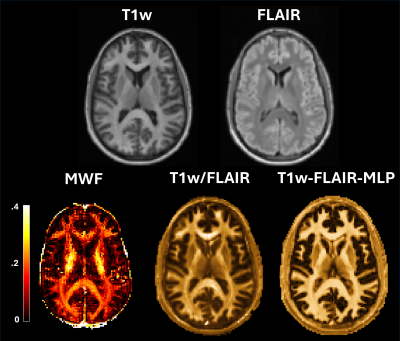 |
Computer Number: 68
1597. Improving
the T1w/FLAIR ratio as a proxy for the myelin content using
machine learning
G. Drenthen, W. Backes, J. Lee, J. Jansen
Maastricht University Medical Center, Maastricht, Netherlands
Impact: The T1w/FLAIR-ratio can be used as a proxy for
the myelin content. Here, we showed that a more optimal
combination of T1w and FLAIR contrasts exist, which relates
to the myelin content better.
|
|
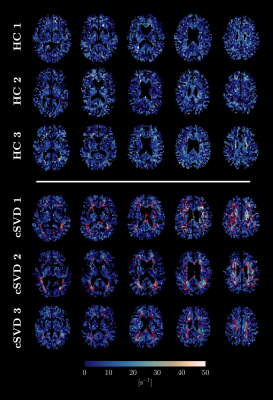 |
Computer Number: 69
1598. Blood-brain
barrier filter exchange imaging (BBB-FEXI) detects altered water
exchange rates in cerebral small vessel disease
E. Powell, M. Maskery, P. Slator, D. Higgins, H. Emsley, L.
Parkes, G. Parker
University College London, London, United Kingdom
Impact: BBB-FEXI was sensitive to BBB water exchange and
microstructural alterations in cSVD. This may provide
insight into the diffuse and heterogeneous disease process
of cSVD, where there is often minimal agreement between
clinical and radiological findings, ultimately improving
patient prognosis.
|
|
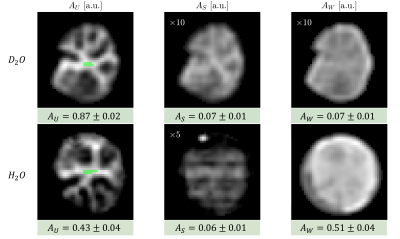 |
Computer Number: 70
1599. Direct
measurements of myelin T1 in ex-vivo brain white matter
L. Bartels, M. Weiger, E. Baadsvik, B. Ineichen, K.
Pruessmann
ETH Zurich and University of Zurich, Zurich, Switzerland
Impact:
In agreement with indirect approaches, this work challenges the common approximation that T1≈1s for the macromolecular pool. Direct T1 mapping of macromolecular proton pools in deuterated and untreated tissue opens new avenues to explore magnetization transfer interactions in white matter. |
|
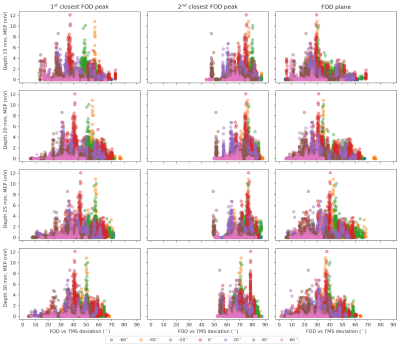 |
Computer Number: 71
1600. Use
of High Angular Resolution Diffusion Imaging to Predict Optimal
Coil Orientation in TMS
M. Szillat, S. Schramm, S. Preis, J. Ten Pas, C. Ramschütz,
S. H. Kim, J. Kirschke, B. Meyer, N. Sollmann, A. Zhylka
Institute for Neuroradiology, TUM University Hospital, School of Medicine and Health, Technical University of Munich, Munich, Germany
Impact: The ability to predict optimal coil orientation
based on microstructural tissue properties could help to
tailor therapeutic TMS to the individual patient, thus
improving clinical TMS applications.
|
|
|
Computer Number:
1601. WITHDRAWN |
||
 |
Computer Number: 72
1602. PSMD
revealed whole brain white matter injury was associated with
cognitive impairment in COVID-19 patients with sequelae
X. Zheng, L. Wu, K. Chen, J. Dai, F. Zhou
Jiangxi Province Medical Imaging Research Institute, Nanchang, Jiangxi, China
Impact: For the first time, our study showed whole brain
white matter injury was associated with cognitive impairment
in COVID-19 patients with sequelae, suggesting the
repairment of white matter should be taken into
considering for further treatment.
|
|
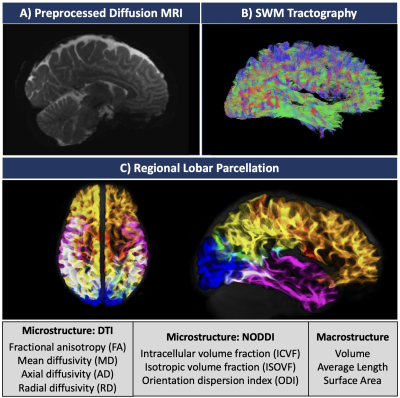 |
Computer Number: 73
1603. Regional
Superficial White Matter Macrostructural and Microstructural
Changes Across the Lifespan
C. Cho, M. Chamberland, E. McMaster, J. Yoon, N. Newlin, D.
Moyer, B. Landman, K. Schilling
Vanderbilt University, Nashville, United States
Impact: This study characterizes typical lobe-specific
changes in SWM integrity and structure across the lifespan.
The normative trajectories of macrostructural and
microstructural properties further lay a foundation for
future research to investigate atypical changes in SWM in
neurologic disease.
|
|
 |
Computer Number: 74
1604. Perivascular
Space as Biomarker for Iron Dysregulation: Evidence from 7T QSM
Paramagnetic and PVS Mapping in Aging
F. Samadi Khoshe Mehr, M. Fotouhi, J. Choupan
University of Southern California, Los Angeles, United States
Impact: The results provide insights into the potential
of PVS mapping, offering an easy-to-compute marker for
assessing iron dysregulation. This study lays the groundwork
for future research on the link between PVS and iron load in
cognitive decline and Alzheimer's disease.
|
|
 |
Computer Number: 75
1605. White
Matter Microstructural Integrity Impairments in Hypothyroidism
Assessed by Tract-based Spatial Statistics
J. Cao, L. Zhao, J. Tian, G. Huang
Gansu Provincial Hospital, Lanzhou, China
Impact: The results highlight specific white matter
changes in hypothyroidism, aiding diagnosis and treatment.
It suggest potential biomarkers for cognitive decline and
encourage research into thyroid dysfunction's impact on
brain structure and new therapeutic approaches targeting
white matter integrity.
|
|
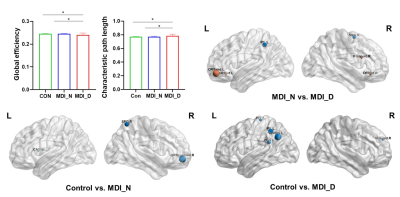 |
Computer Number: 76
1606. Structural
Network Efficiency as an Early Predictor of Cognitive Delay in
Premature Infants with Mild PWML: A Longitudinal Cohort Study
M. Wang, C. Liu, X. Li, P. Bai, X. Wang, C. Liu, C. Da, S.
Wang, X. Huang, Z. Li, J. Yang
the First Affiliated Hospital of Xi’an Jiaotong University, Xi'an, China
Impact: This result can offer an early screening plan
for identifying preterm infants with mild PWML who are at
risk of poor cognitive prognosis, which is beneficial for
early intervention and improving outcomes.
|
|
 |
Computer Number: 77
1607. The
effects of medication on white matter integrity in
obsessive-compulsive disorder
S. Chai, H. Li, J. Jiang, L. Cao, H. Zhou, B. Li, X. Huang
Department of Radiology and Huaxi MR Research Center (HMRRC), Functional and Molecular Imaging Key Laboratory of Sichuan Province, West China Hospital, Sichuan University, Chengdu, China
Impact: Although pharmacological treatment led to
symptom relief in patients with OCD, this improvement was
not reflected in structural connectivity. This suggests
symptom alleviation in OCD may precede detectable changes in
white matter microstructure following treatment.
|
|
 |
Computer Number: 78
1608. Unveiling
Paramagnetic and Diamagnetic Susceptibility Mechanisms in
Cuprizone-Induced Demyelination
J. Chen, J. Chen, R. Hu, Z. Liu, X. Han, L. Feng, N. Wang
New York University Grossman School of Medicine, New York, United States
Impact: Our findings reveal that cuprizone-induced
demyelination involves diamagnetic degradation and
paramagnetic deposition, underscoring the roles of PCS and
DCS in guiding treatment strategies and furthering
demyelination research.
|
|
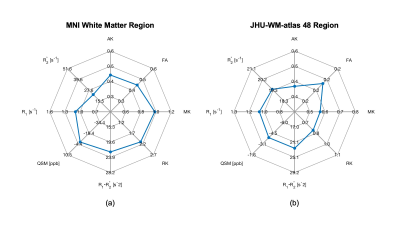 |
Computer Number: 79
1609. Feature
Extraction of White Matter Structures Using Quantitative
Parameter Mapping: Comparison of Relaxometry, Susceptibility,
and Diffusion
E. Sato, Y. Kanazawa, M. Harada, Y. Taniguchi, M. Takizawa,
A. Haga
Tokushima University, Tokushima, Japan
Impact: Relaxation rate, susceptibility, and diffusion
parameters have different characteristics for each WM
region.
|
The International Society for Magnetic Resonance in Medicine is accredited by the Accreditation Council for Continuing Medical Education to provide continuing medical education for physicians.